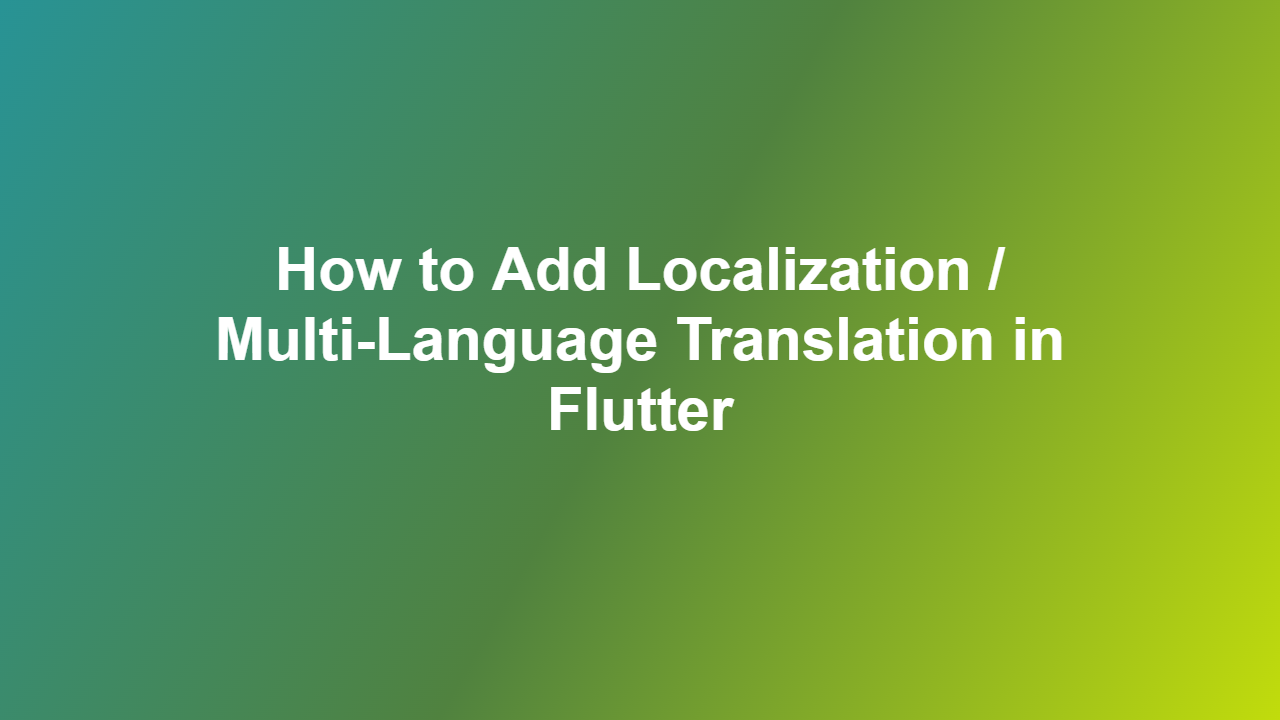How to Add Localization / Multi-Language Translation in Flutter
Introduction
Flutter is a popular framework for building cross-platform applications, and one of the key aspects of making an app accessible to a global audience is localization. Localization, also known as multi-language translation, is the process of adapting an application to meet the language and cultural requirements of different regions. In this blog post, we will explore how to add localization to a Flutter app.
Getting Started with Localization
To get started with localization in Flutter, we need to generate the necessary files and configure our app to support multiple languages. We can use the `intltranslation` package to generate the necessary files for localization. First, we need to add the `intltranslation` package to our `pubspec.yaml` file. Then, we need to create a new file called `locale.dart` to handle the localization logic.
Implementing Localization
To implement localization in our Flutter app, we need to use the `intl` package. We can use the `Intl` class to define the translations for our app. Here is an example of how we can define translations for our app:
“`dart
import ‘package:flutter/material.dart’;
import ‘package:intl/intl.dart’;
class LocaleUtils {
static Future
await initializeMessages(context);
}
static String translate(BuildContext context, String key) {
return Intl.message(key, name: key);
}
}
“`
In the above code, we are using the `Intl.message` function to define the translations for our app. We can use the `Intl.message` function to define the translations for different languages.
Adding Support for Multiple Languages
To add support for multiple languages in our Flutter app, we need to create separate files for each language. For example, if we want to add support for English and Spanish, we need to create two separate files called `messagesen.json` and `messageses.json`. Here is an example of what the `messages_en.json` file might look like:
“`json
{
“hello”: “Hello”,
“goodbye”: “Goodbye”
}
“`
And here is an example of what the `messages_es.json` file might look like:
“`json
{
“hello”: “Hola”,
“goodbye”: “Adiós”
}
“`
We can then use the `LocaleUtils` class to switch between different languages.
Using the LocaleUtils Class
To use the `LocaleUtils` class, we need to initialize it in our `main` function. Here is an example of how we can use the `LocaleUtils` class:
“`dart
import ‘package:flutter/material.dart’;
import ‘package:yourapp/localeutils.dart’;
void main() async {
await LocaleUtils.initializeLocale(null);
runApp(MyApp());
}
class MyApp extends StatelessWidget {
@override
Widget build(BuildContext context) {
return MaterialApp(
title: LocaleUtils.translate(context, ‘hello’),
home: Scaffold(
appBar: AppBar(
title: Text(LocaleUtils.translate(context, ‘hello’)),
),
body: Center(
child: Text(LocaleUtils.translate(context, ‘goodbye’)),
),
),
);
}
}
“`
In the above code, we are using the `LocaleUtils` class to initialize the localization logic and to translate the text.
Conclusion
Adding localization to a Flutter app is a straightforward process that involves generating the necessary files, configuring our app to support multiple languages, and using the `intl` package to define the translations. By following the steps outlined in this blog post, we can easily add localization to our Flutter app and make it accessible to a global audience.
FAQ
Q: What is localization in Flutter?
A: Localization in Flutter is the process of adapting an application to meet the language and cultural requirements of different regions.
Q: How do I add localization to a Flutter app?
A: To add localization to a Flutter app, you need to generate the necessary files, configure your app to support multiple languages, and use the `intl` package to define the translations.
Q: What is the `intl` package in Flutter?
A: The `intl` package in Flutter is a package that provides support for internationalization and localization.
Q: How do I define translations for my app?
A: You can define translations for your app using the `Intl.message` function.
Q: Can I use localization with other packages in Flutter?
A: Yes, you can use localization with other packages in Flutter, such as the `provider` package and the `bloc` package.
